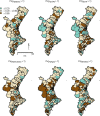Joint spatial modeling to identify shared patterns among chronic related potentially preventable hospitalizations
- PMID: 24899214
- PMCID: PMC4053553
- DOI: 10.1186/1471-2288-14-74
Joint spatial modeling to identify shared patterns among chronic related potentially preventable hospitalizations
Abstract
Background: Rates of Potentially Preventable Hospitalizations (PPH) are used to evaluate access of territorially delimited populations to high quality ambulatory care. A common geographic pattern of several PPH would reflect the performance of healthcare providers. This study is aimed at modeling jointly the geographical variation in six chronic PPH conditions in one Spanish Autonomous Community for describing common and discrepant patterns, and to assess the relative weight of the common pattern on each condition.
Methods: Data on the 39,970 PPH hospital admissions for diabetes short term complications, chronic obstructive pulmonary disease (COPD), congestive heart failure, dehydration, angina admission and adult asthma, between 2007 and 2009 were extracted from the Hospital Discharge Administrative Databases and assigned to one of the 240 Basic Health Zones. Rates and Standardized Hospitalization Ratios per geographic unit were estimated. The spatial analysis was carried out jointly for PPH conditions using Shared Component Models (SCM).
Results: The component shared by the six PPH conditions explained about the 36% of the variability of each PPH condition, ranging from the 25.9 for dehydration to 58.7 for COPD. The geographical pattern found in the latent common component identifies territorial clusters with particularly high risk. The specific risk pattern that each isolated PPH does not share with the common pattern for all six conditions show many non-significant areas for most PPH, but with some exceptions.
Conclusions: The geographical distribution of the risk of the PPH conditions is captured in a 36% by a unique latent pattern. The SCM modeling may be useful to evaluate healthcare system performance.
Figures



References
-
- Agency for Healthcare Research and Quality. Guide to prevention quality indicators: hospital admission for ambulatory care sensitive conditions (version 3.1) Agency for Healthcare Research and Quality. 2007. Available at: http://www.qualityindicators.ahrq.gov/Downloads/Modules/PQI/V31/pqi_guid.... Accessed July 20, 2013.
-
- Magán P, Alberquilla A, Otero A, Ribera JM. Hospitalizations for ambulatory care sensitive conditions and quality of primary care: their relation with socioeconomic and health care variables in the Madrid regional health service (Spain) Med Care. 2011;49(1):17–23. doi: 10.1097/MLR.0b013e3181ef9d13. - DOI - PubMed
-
- García-Armesto S, Gil Lapetra ML, Wei L, Kelley E, and the Members of the HCQI Expert Group. OECD Health Working Papers NO 29. Paris: OECD; 2007. Health Care Quality Indicators Project 2006. Data Collection Update Report. Available at: http://www.oecd.org/els/health-systems/39447928.pdf. Accessed August 15, 2013.
-
- Statistics Canada, Health Information and Research Division. Hospitalizations for ambulatory care sensitive conditions (ACSC) the factors that matter. Ottawa: Statistics Canada, Health Information and Research Division; 2011. Available at: http://epe.lac-bac.gc.ca/100/200/301/statcan/health_research_working_pap.... Accessed July 25, 2013.
Publication types
MeSH terms
LinkOut - more resources
Full Text Sources
Other Literature Sources
Medical

